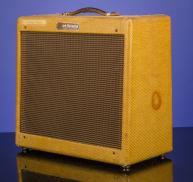1961 Fender "Narrow-Panel" Tweed Harvard SF10
"A Classic Ten Watt, Class-A Wonder"
1961 Fender Harvard SF10
This is an all original Harvard SF10, 10 watt tweed "narrow-panel" cabinet tube combo legend weighing just 20 lbs. The solid pine cabinet measures 18 inches wide x 16 1/2 inches high. The depth of the cabinet is 7 3/4 inches at the top expanding to 8 3/4 inches at the bottom. One original ten-inch Oxford Alnico speaker stamped in black on rim "KE" (May, 1961). Top control panel with three instrument inputs, one volume control and one tone control. Original tweed covering with original brown tweed-era grill cloth. The potentiometers are stamped "304 5939" and "304 6102" (Stackpole, September 1959 and January 1961). The transformers are stamped "125 AIA / 606 040" and "125 PIA / 606 109" (Woodward-Schumacher, October 1960 and January 1961). The serial number "H 03741" is stamped in blind on the control panel. On the tube chart, the letters "KE" are stamped in black and the number "22" is written in red pen. The electrics appear to be 100% original and untouched other than changed (5Y3GT; 6V6GT (x2); 12AX7 and 6AT6) tubes. The original tweed covering is very slightly worn and there are two 'circular' stains on the top and one on the right-hand side of the cabinet. The original leather handle has slight wear. An incredible little fifty-four-year old legend… just turn it up for real tube gain at a reasonable volume.
"The Harvard amp joined Fender's growing line in late 1955, either as the company's smallest amp for professional use or a a super practice amp. With a single 10" speaker and two 6V6 power tubes producing 10 watts, the Harvard filled a gap between the 1x12 15-watt Deluxe and the 1x8 4 1/2-watt Princeton. Like the Princeton, the Harvard featured Volume and Tone controls, a fuse holder, a pilot light, and an On/Off switch. The dimensions of the narrow-panel cabinet matched those of the big-boxed, narrow-panel Princeton. Price lists starting with November '55 through February '61, and the eight-page catalogs from '56 to '60, specified a 10" speaker; but the full-line catalogs from '56 to '60 specified an 8". At least one version of the single-page spec sheet from the dealer notebook shows "8" hand-written over the top of "10." So what size speaker was in the real thing? It appears both were used at different times.
A 12AX7 performed double duty, with one side as the second preamp stage and the other as a phase splitter (split-load inverter). This had become standard Fender practice in '55, as had the fixed bias for the power tubes. A 5Y3GT rectifier was also standard issue on the smaller amps. The first preamp stage was a 6AV6 single triode, and this was not standard Fender practice at the time. Previously, the thrifty designers used twin triodes almost exclusively in the preamp and phase inverter circuits. The mate to the Harvard, the Vibrolux, was basically the same amp except for a 12AX7 in place of the 6AV6, with one half doing the 6AV6's job and the other used for the tremolo. On later amps needing a single preamp stage, Fender would use a 12AX7 and hook up only one side, a more practical approach than trying to find a 6AV6. A lower-gain version, the 6AT6, replaced the 6AV6 in '56 (model SF10) and was used on the majority of the production models. (is this a hint, Harvard owners?) The Harvard was discontinued when the Princeton was upgraded to two 6V6s, a 10" speaker, tremolo, and brown tolex in '61" (Teagle & Sprung. Fender Amps: The First Fifty Years. pp. 97/98.)





















